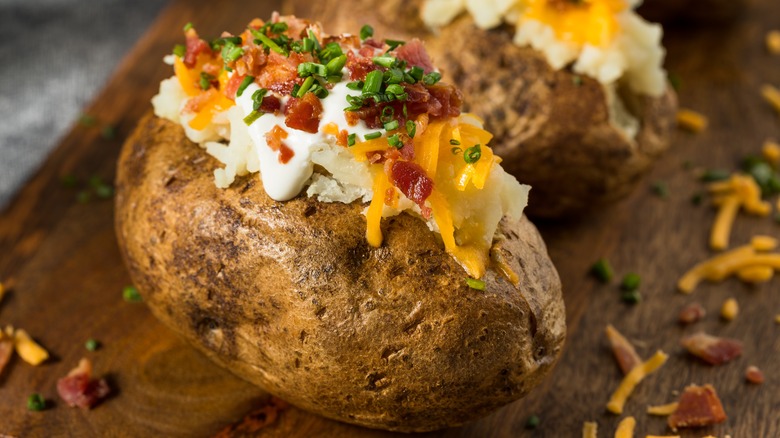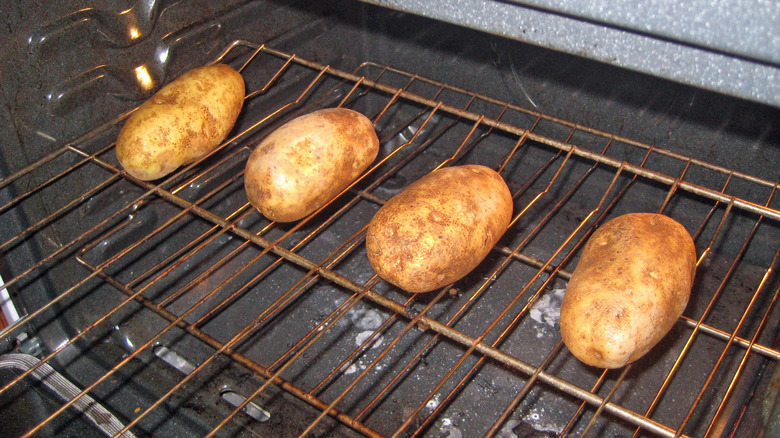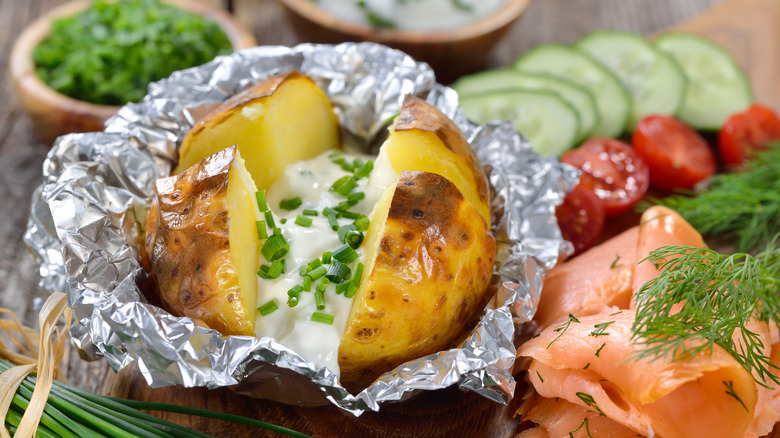For A Fluffier Baked Potato, Ditch The Aluminum Foil
If you're still baking potatoes in aluminum foil, you're missing out on truly tasty taters. Using foil is one of the most common baked potato mistakes, possibly because many aluminum aficionados believe that the heat-conducting layer will dramatically cut cooking time (spoiler alert: it won't). Letting baked potatoes cook directly on an oven rack or baking sheet not only reduces waste — it also results in a seriously superior spud. Potatoes that are cooked without foil get a deliciously crispy exterior and a fluffy interior that thirstily soaks up butter and sour cream.
That's because a raw potato is made up of about 80% water. As your tater cooks, all of that water converts into steam, which in turn fluffs up the starchy grains that make up its fleshy interior. Russets and other types of potatoes that are low in moisture and high in starch are the best at demonstrating this delicious phenomenon. When that steam is trapped in a silver, crinkly prison, it's reabsorbed into the potato's skin and flesh. The result is a baked potato that's disappointingly dense with sad, soggy skin. On the flip side, a potato that's free from foil can reach its fluffy potential as steam escapes through the holes you've poked through its skin, allowing the starches to separate and become light and airy while the outside takes on a crispy crust.
How to cook fluffy baked potatoes without foil
Cooking fluffy baked potatoes couldn't be simpler. As always, remember to poke holes so the steam can escape, or you'll risk a starchy explosion in your oven. For extra crispy skin, massage your taters with olive oil and salt, or prep your baked potatoes in a saltwater brine before cooking. If needed, place them on a baking sheet to catch any drippings. After preheating your oven to 400 degrees Fahrenheit, place your spuds directly on the oven rack or baking sheet and cook them for about 60 minutes or until you can easily poke through to the center with a knife.
If you're still tempted to use foil to cut cooking time, there's a better way. A potato nail or a metal skewer, pierced all the way through the spud, acts as a heat conductor. It can easily speed up cooking by up to seven minutes because it helps heat reach the centermost part of the flesh, which can take the longest time to cook.
After removing your taters from the oven, make sure to cut them open right away. Unlike other foods, such as meat and bread, baked potatoes do not improve with resting. In fact, leaving your baked potato whole after cooking may allow it to overcook, resulting in a dense, gummy interior. To achieve that perfectly airy texture, cut your potatoes down the middle, add toppings, and serve as soon as possible.
Should you wrap baked potatoes in foil after cooking?
Since baked potatoes require an hour or more in the oven, it makes sense that many restaurants keep them warm with a layer of foil. While foil is not the best medium for cooking, it's still great for insulating your potatoes if you need to keep them warm for up to 45 minutes before dinner. That way, you don't have to leave them in the oven, where they can become overcooked with a dry, wrinkled skin.
Aluminum foil's insulating property can have its drawbacks, though. A potato that's allowed to steam in a foil wrapping won't be quite as tasty as it will be fresh out of the oven. More importantly, according to State Food Safety, too much time in its wrapping can increase the risk of botulism. That's because the foil keeps out oxygen, creating an environment that allows botulism-causing bacteria to thrive. Wrapped baked potatoes may also spend more time in the temperature danger zone, between 40 and 140 degrees Fahrenheit, in which bacteria can multiply rapidly. Baked potatoes should be eaten within two hours, and any leftovers should be removed from foil and refrigerated.



